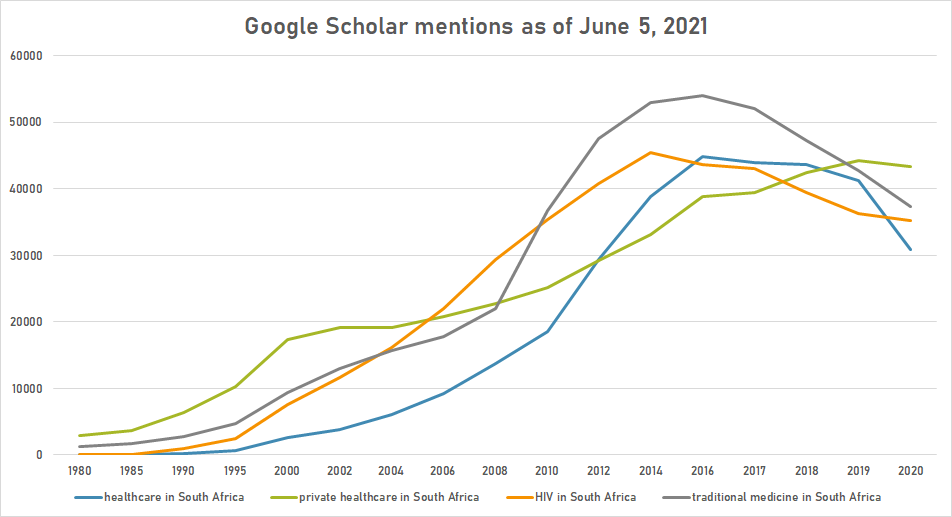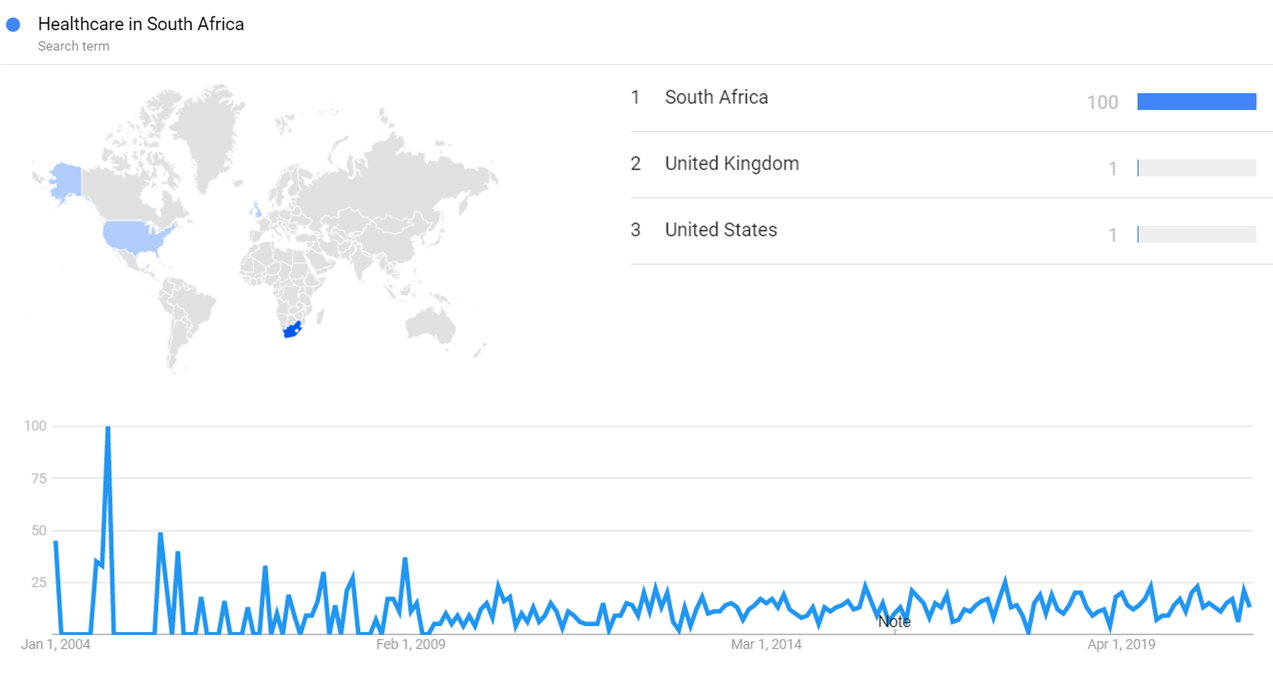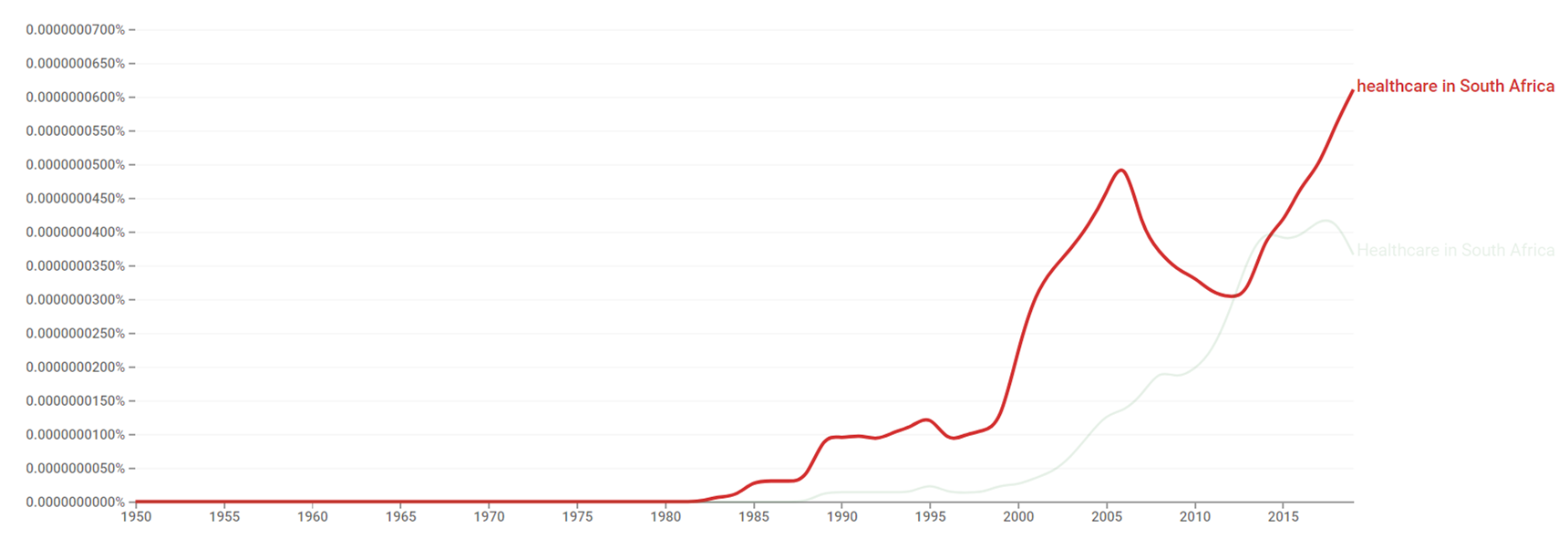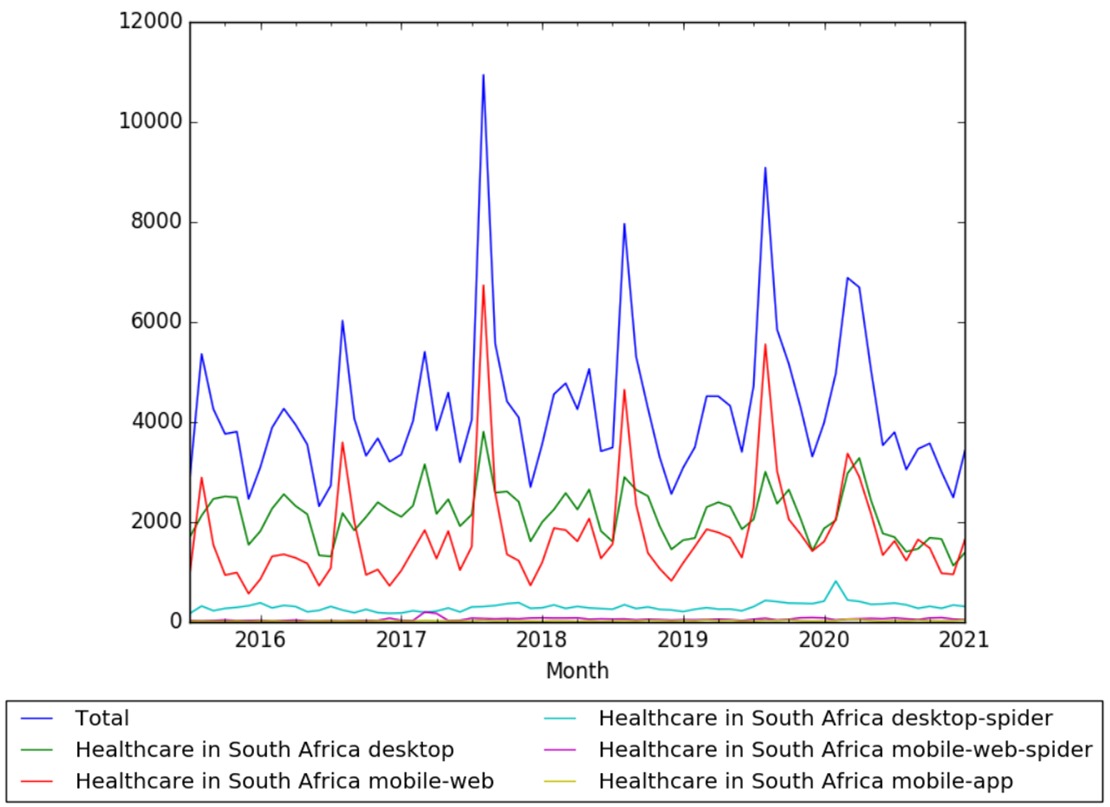Timeline of healthcare in South Africa
This is a timeline of healthcare in South Africa, focusing especially on modern science-based medicine healthcare. Major events such as policies and organizations are described.
Big picture
| Year/period | Key developments |
|---|---|
| 17th–18th centuries | Hospital care is provided by the Dutch East India Company, colonial governments, and Christian missions. Traditional healers, European trained doctors, missionaries, and other health providers offer a mix of services.[1] |
| 19th century | Medically trained doctors become mainstream. Indigenous and traditional healers are marginalized. Orthodox medicine becomes a professional practice with training of nurses and doctors. By mid-century, hospitals are present in most major centers. Epidemics of syphilis, tuberculosis, bubonic plague, yellow fever, typhus, cholera, soil parasites, and malnutrition hit South Africa.[1] |
| 1910–1948 | The Union of South Africa is established. Health services are fragmented among the four provinces. Poor urban working and living conditions with diseases are caused by overcrowding, poor sanitation and diets, stress, and social disintegration follow consolidation of racial segregation. Syphilis, tuberculosis, malaria and venereal diseases continue to spread.[1] |
| 1948–1994 | Apartheid years. Non-communicable diseases rise in white people and poverty-related diseases persist in black people. Tuberculosis rates and deaths are much higher in black and coloured populations than among whites. Health services in bantustans are systematically underfunded.[1] |
| 1994–present | Post-apartheid democracy. Today, the public system serves the vast majority of the population, but it still remains underfunded and understaffed. The wealthiest 20% of the population use the private system and are far better served.[1] Diseases of poverty, non-communicable diseases and HIV/AIDS comprise a huge burden for South Africa. |
Full timeline
| Year/period | Type of event | Event | Location |
|---|---|---|---|
| 1807 | Policy | The first health legislation is enacted. A Supreme Medical Committee is established to oversee all health matters.[1] | |
| 1830 | Policy | Ordinance 82 allows for regulation of all health practices in the Cape Colony. Other three colonies follow.[1] | |
| 1855 | Organization | Grey’s Hospital is established.[2] | Pietermaritzburg, KwaZulu-Natal |
| 1881 | Organization | Frere Hospital is established.[3] | East London, Eastern Cape |
| 1883 | Policy | Public Health Act makes notification and inoculation of smallpox compulsory in response to smallpox epidemic.[1] | |
| 1890 | Organization | Valkenberg Hospital is founded.[4] | |
| 1892 | Organization | Weskoppies Psychiatric Hospital is founded. It is the first psychiatric institution established in the Zuid-Afrikaansche Republiek.[5] | Pretoria, Gauteng |
| 1897 | Policy | Public Health Amendment Act is launched. It separates curative and preventive care.[1] | |
| 1919 | Organization | Health Act establishes the first Unionwide Public Health department in South Africa.[1] | |
| 1933 | Organization | Umlamli Hospital is established.[6] | Sterkspruit, Eastern Cape |
| 1938 | Organization | Groote Schuur Hospital is founded. It is the chief academic hospital of the University of Cape Town's medical school.[7] | Cape Town |
| 1940 | Report | There's an overall ratio of one doctor per 3600 population. There's one doctor for every 308 white people in Cape Town compared with one doctor for 22,000 to 30,000 people in the reserves.[1] | |
| 1942 | Organization | Chris Hani Baragwanath Hospital is founded. It is the largest hospital in the southern hemisphere and the third largest in the world.[8] | Johannesburg |
| 1942–1944 | The National Health Service Commission (also called Gluckman Commission) is carried out. It advocates for a unitary national health service in South Africa.[1] | ||
| 1951 | Organization | Segregated black medical faculty is created at the University of Natal (UNB).[9] | KwaZulu-Natal |
| 1955 | Organization | Fort Grey TB Hospital is founded.[10] | East London, Eastern Cape |
| 1959 | Organization | Madwaleni Hospital is founded.[11] | Elliotdale, Eastern Cape |
| 1966 | Organization | Jose Pearson TB Hospital is founded.[12] | Port Elizabeth, Eastern Cape |
| 1967 | Achievement | South African cardiac surgeon Christiaan Barnard performs the world's first human heart transplant operation at Groote Schuur Hospital.[13] | Cape Town |
| 1972 | Organization | Kalafong Hospital is founded. The University of Pretoria uses the hospital as a training institution for the Faculty of Health Sciences.[14] | |
| 1976 | Organization | Tygerberg Hospital is founded. It is the second largest hospital in South Africa.[15] | Bellville, Western Cape |
| 1977 | Organization | Second training site for black medical students is created at the Medical University of South Africa (MEDUNSA).[9] | Pretoria, Gauteng |
| 1977 | Policy | Health Act is passed, perpetuating the fragmentation with curative services being a provincial responsibility and prevention a local government responsibility.[1] | |
| 1983 | Policy | Tricameral Parliament further fragments health services with white, coloured, and Indian own affairs departments.[1] | |
| 1994 | Policy | First democratic elections in South Africa are held. The country's race-based health system begins dismantling. A policy on universal access to primary healthcare is introduced.[16] | |
| 1996 | Policy | Choice on Termination of Pregnancy Act is passed. This legislation legalizes abortion and allows for safe access to it in both public and private health facilities.[16] | |
| 1996 | Policy | Free care for children younger than 6 years and pregnant women, and free primary health care for all South Africans is instituted.[1] | |
| 1998 | Program | A National Telemedicine Project Strategy is adopted by the South African Department of Health. The system facilitates frequent contact between doctors in underdeveloped and developed areas.[16] | |
| 1998 | Policy | Medical Schemes Act is passed. This legislation regulates the medical schemes industry to prevent it from discriminating against "high risk" individuals like the aged and sick.[16] | |
| 1999 | Policy | Tobacco Products Control Amendment Act is passed. This legislation limits smoking in public places and makes the public aware of the health risks of tobacco by placing restrictions on tobacco advertisements.[16] | |
| 2000 | Policy | Pharmacy Amendment Act is passed. This legislation allows non-pharmacists to own pharmacies, with the aim of improving access to medicines.[16] | |
| 2001 | Policy | Free Basic Water Strategy defines water as a social and developmental good and basic human right.[1] | |
| 2002 | Policy | Mental Healthcare Act is passed. This legislation introduces a process to develop and redesign mental health services so as to grant basic rights to people with mental illnesses.[16] | |
| 2003 | Program | The South African government launches the Hospital Revitalisation Programme, with a total budget of R 1.9 billion, in an attempt to improve the public health system. Under the program, hospital infrastructure, procurement of the necessary equipment and management skills are improved.[16] | |
| 2003 | Organization | The National Reference Centre for African Traditional Medicines is launched to research African herbs and to evaluate their medicinal value.[16] | |
| 2004 | Program | The South African government launches the Community Health Worker Programme to develop community-based generalist health workers. Their training combines competencies in health promotion, disease prevention, primary healthcare and health-resource networking, as well as coordination. 40,000 such workers are estimated to be in South Africa.[16] | |
| 2004 | Policy | National Health Act is passed. Under this legislation, both the district health system and primary health care are defined as provincial responsibilities.[1] | |
| 2005 | Policy | Nursing Act is passed. This legislation provides for the introduction of mandatory community service for nurses.[16] | |
| 2006 | Program | The National Human Resource Plan is launched by the South African Department of Health in an attempt to make up for the skills shortfall and to compensate for the loss of experienced health professionals from rural to urban areas, from the public to private sector, and from South Africa mainly to developed countries.[16] | |
| 2006 | Study | The Medicines Research Council (MRC) initiates toxicology studies to further study selected indigenous plants.[16] | |
| 2006 | Program | The Accelerated Prevention of HIV/Aids Initiative is launched as part of an extensive initiative regarding prevention by the member states of the Africa region of the WHO. More than 1 060 health professionals are recruited to support the program. Some 7 600 health professionals are trained in the management, care and treatment of HIV/AIDS. 213 000 patients initiate on antiretroviral treatment by the end of September 2006, and an estimated additional 90,000 to 100,000 patients initiate in the private and nongovernmental sector.[16] | |
| 2007 | Program | The South African government enters into an agreement to recruit 2,000 Tunisian doctors to combat long standing shortage of doctors in rural areas. The Department of Health also employs 450 doctors from Cuba and Iran.[16] | |
| 2007 | Program | A new cadre of health professionals called clinical associates is introduced to lighten the workload at health facilities. Graduates are expected to work under the supervision of medical officers in district hospitals and primary healthcare level.[16] | |
| 2007 | Campaign | The South African Department of Health launches a nationwide Polio and Measles Immunisation Campaign. It is aimed at boosting the immunization coverage in the country.[16] | |
| 2010 | Report | 150,509 qualified health practitioners in both public and private sectors are registered with the Health Professions Council of South Africa. This includes 30,006 doctors and 5,185 dentists.[16] | |
| 2016 | Report | Life expectancy in South Africa is estimated at 49.99 years, being ranked 228th out of 228 political subdivisions.[17] South Africa is reported to have the lowest life expectancy in the world.[18] |
Numerical and visual data
Google Scholar
The following table summarizes per-year mentions on Google Scholar as of June 5, 2021.
| Year | healthcare in South Africa | private healthcare in South Africa | HIV in South Africa | traditional medicine in South Africa |
|---|---|---|---|---|
| 1980 | 50 | 2,930 | 84 | 1,310 |
| 1985 | 73 | 3,680 | 121 | 1,710 |
| 1990 | 192 | 6,320 | 1,010 | 2,820 |
| 1995 | 609 | 10,300 | 2,430 | 4,700 |
| 2000 | 2,660 | 17,300 | 7,570 | 9,330 |
| 2002 | 3,840 | 19,100 | 11,700 | 13,000 |
| 2004 | 6,150 | 19,100 | 16,100 | 15,700 |
| 2006 | 9,190 | 20,800 | 22,000 | 17,800 |
| 2008 | 13,800 | 22,800 | 29,300 | 22,000 |
| 2010 | 18,600 | 25,200 | 35,400 | 36,700 |
| 2012 | 29,400 | 29,200 | 40,800 | 47,600 |
| 2014 | 38,800 | 33,200 | 45,500 | 53,000 |
| 2016 | 44,800 | 38,800 | 43,700 | 54,000 |
| 2017 | 43,900 | 39,500 | 43,100 | 52,100 |
| 2018 | 43,600 | 42,400 | 39,500 | 47,200 |
| 2019 | 41,200 | 44,300 | 36,300 | 42,800 |
| 2020 | 30,900 | 43,300 | 35,300 | 37,300 |

Google Trends
The image below shows Google Trends data for Healthcare in South Africa (Search term) from January 2004 to February 2021, when the screenshot was taken. Interest is also ranked by country and displayed on world map.[19]

Google Ngram Viewer
The chart below shows Google Ngram Viewer data for Healthcare in South Africa, from 1950 to 2019.[20]

Wikipedia Views
The chart below shows pageviews of the English Wikipedia article Healthcare in South Africa, on desktop, mobile-web, desktop-spider, mobile-web-spider and mobile app, from July 2015 to January 2021.[21]

See also
References
- ↑ 1.00 1.01 1.02 1.03 1.04 1.05 1.06 1.07 1.08 1.09 1.10 1.11 1.12 1.13 1.14 1.15 1.16 "The health and health system of South Africa: historical roots of current public health challenges" (PDF). Retrieved 4 October 2016.
- ↑ "GREY'S HOSPITAL". Retrieved 10 October 2016.
- ↑ "Frere". Retrieved 20 November 2016.
- ↑ "Valkenberg". Retrieved 20 November 2016.
- ↑ "HISTORY OF MEDICINE" (PDF). Retrieved 4 October 2016.
- ↑ "Umlami". Retrieved 20 November 2016.
- ↑ "Groote Schuur Hospital: Overview". Retrieved 6 October 2016.
- ↑ "The Chris Hani Baragwanath Hospital". Retrieved 3 October 2016.
- ↑ 9.0 9.1 Digby, A (2013). "Black Doctors and Discrimination under South Africa's Apartheid Regime". Med Hist. 57: 269–90. doi:10.1017/mdh.2012.106. PMC 3867842. PMID 24070349.
- ↑ "Fort Grey TB Hospital". Retrieved 20 November 2016.
- ↑ "Madwaleni Hospital". Retrieved 6 October 2016.
- ↑ "Jose Pearson TB Hospital". Retrieved 20 November 2016.
- ↑ "Dr Chris Barnard performs the world's first human heart transplant". Retrieved 6 October 2016.
- ↑ "Kalafong Hospital". Retrieved 4 October 2016.
- ↑ "Tygerberg Hospital: Overview". Retrieved 4 October 2016.
- ↑ 16.00 16.01 16.02 16.03 16.04 16.05 16.06 16.07 16.08 16.09 16.10 16.11 16.12 16.13 16.14 16.15 16.16 16.17 "Healthcare in South Africa". Retrieved 3 October 2016.
- ↑ "Life Expectancy". Retrieved 10 October 2016.
- ↑ "South Africa has the lowest life expectancy in the world". Retrieved 10 October 2016.
- ↑ "Healthcare in South Africa". Google Trends. Retrieved 25 February 2021.
- ↑ "Healthcare in South Africa". books.google.com. Retrieved 25 February 2021.
- ↑ "Healthcare in South Africa". wikipediaviews.org. Retrieved 24 February 2021.
Category:Health in South Africa Category:Health-related timelines